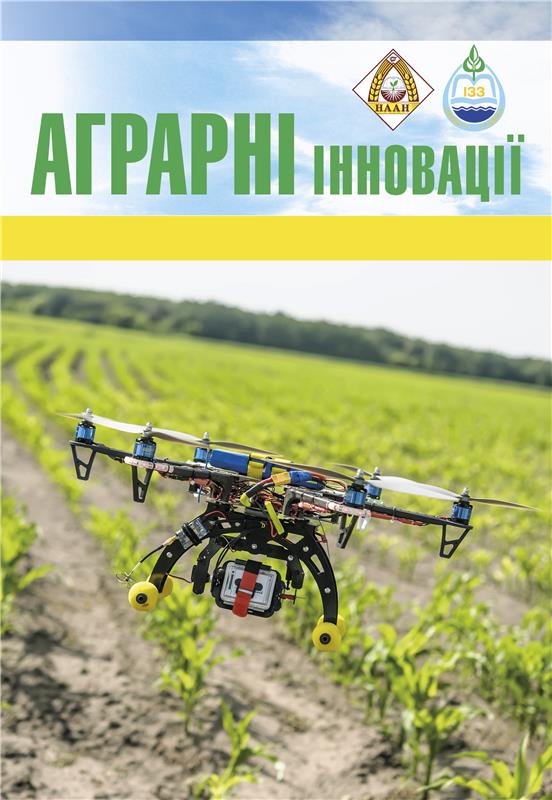TILLAGE OF BLACK FALLOW AS A FACTOR IN STABILIZING GRAIN YIELD OF WINTER WHEAT UNDER CONDITIONS OF THE NORTHERN STEPPE OF UKRAINE
Abstract
Purpose. To determine the impact of different primary tillage methods in black fallow on the agrophysical properties of ordinary chernozem, soil water-physical regime, and winter wheat productivity under the conditions of the Northern Steppe of Ukraine. Methods. From 2021 to 2023, a field study was conducted at the State Enterprise Experimental Farm «Dnipro» of the Institute of Grain Crops of NAAS of Ukraine to evaluate three primary tillage methods: ploughing to a depth of 23–25 cm (PO-3-35), chisel loosening to 30–32 cm (GRD-3), and shallow disk tillage to 10–12 cm (BGR-4,2). The winter wheat variety used in the study was «Zhytnytsia Odeska». The study evaluated soil agrophysical parameters, water availability, yield, and the economic efficiency of the technologies.Results. The study revealed that chisel tillage provided the highest proportion of erosion-resistant aggregates in the arable soil layer (81.1%), while ploughing reduced this parameter to 71.2%. Disk tillage produced intermediate results (80.1%). The soil bulk density in the 0–30 cm layer at the end of the fallow period was 1.26 g/cm³ for chisel tillage, 1.22 g/cm³ for ploughing, and 1.30 g/cm³ for shallow tillage. The highest level of soil moisture (22.9% in the 0–100 cm layer) was recorded with chisel tillage, exceeding ploughing and disk tillage by 0.5–1.6%. Winter wheat yield under chisel tillage reached 4.97 t/ha, which was 0.36 t/ha higher than ploughing and 0.54 t/ha higher than shallow tillage. The economic efficiency of chisel tillage was the highest due to reduced resource costs and improved profitability. Conclusions. Chisel tillage in black fallow proved to be the most effective method for preserving chernozem fertility, enhancing soil moisture, and ensuring stable winter wheat productivity. Its application optimizes the agrophysical condition of the soil, reduces deflation risks, increases water availability, and achieves economically viable yield levels.
References
2. Гадзало Я. М., Ібатуллін І. І., Лузан Ю. Я. Інституціональне забезпечення функціонування продовольчої системи України в сучасних кризових умовах. Вісник аграрної науки. 2022. № 8. С. 5–15. https://doi.org/10.31073/agrovisnyk202208-01.
3. Горбатенко А. І., Горобець А. Г., Цилюрик О. І. Водний режим ґрунту і урожайність озимої пшениці за різних способів обробітку чистого пару. Бюлетень Інституту зернового господарства. 2008. № 33–34. С. 7–11.
4. Гордієнко В. П., Геркіял О. М., Опришко В. П. Землеробство. К. : Вища школа, 1991. 268 с.
5. Державний реєстр сортів рослин, придатних для поширення в Україні на 2018 рік. Київ, 2018. 447 с.
6. Лебідь Є. М. Науковий фундамент проблем степового землеробства. Вісник аграрної науки. Київ, 2006. № 3–4. С. 23–25.
7. Мазур В. А., Липовий В. Г., Мордванюк М. О. Методика наукових досліджень в агрономії: навчальний посібник. Вінниця : ВЦ ТОВ «ТВОРИ», 2020. 204 с.
8. Пікуш Г. Р., Гетманець А. Я., Лебідь Є. М., Пабат І.А. Чорний пар. Кіїв : Урожай, 1992. 168 с.
9. Ушкаренко В. О., Нікішенко В. Л., Голобородько С. П., Коковіхін С. В. Дисперсійний і кореляційний аналіз у землеробстві та рослинництві: навч. посіб. Херсон : Айлант, 2008. 272 с.
10. Шевченко М. С., Шевченко О. М., Швець Н. В. Агродинаміка вологоспоживання залежно від технологічних факторів землеробства степової зони. Бюлетень Інституту сільського господарства степової зони НААН України. 2013. № 5. 130–134.
11. Achankeng E., Cornelis W. Conservation tillage effects on European crop yields: A meta-analysis. Field Crops Research. 2023. Vol. 298, № 3. P. 108967. https://doi. org/10.1016/j.fcr.2023.108967.
12. Busar M. A., Kukal, S. S., Kaur A., Bhatt R., Dulazi A.A. Conservation tillage impacts on soil, crop and the environment. International soil and water conservation research. 2015. Vol. 3, № 2. Р. 119–129. https://doi. org/10.1016/j.iswcr.2015.05.002.
13. Kaminskyi V., Bulgakov V., Tkachenko M., Kolomiіets M., Kaminska V., Ptashnik M., Kiernicki, Z. Research into Comparative Performance of Different Tillage and Fertilization Systems Applied to Grey Forest Soil of Forest Steppe in Grain Crop Rotation. Journal of Ecological Engineering. 2022. Vol. 23. № 12. P. 163–178. https://doi.org/10.12911/22998993/155057.






